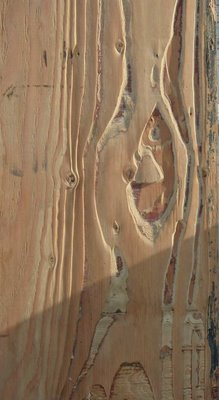ARNESON, ALBERTA

Arneson was located NE of Acadia Valley, and had an Alberta Wheat Pool elevator. It was built in 1927, and was closed in 1972. All that is left is this sign... located on Secondary 889 or Range Road 1-3, and about 1 mile north of Township Road 25-0.
EMPRESS, ALBERTA
Empress is located about 20 km south of Acadia Valley on Highway 41 and 14 km west on Secondary 562. This town, located on the CP line (The Royal Line) which ran east from Bassano to Empress and into Saskatchewan, had 4 elevators, plus a rail station and roundhouse.

This elevator was privately built, and is located NW of Empress on Range Rd 2-0 north of Secondary 562.


This photo is of the elevators which were in Empress, and the second one is of the station, which I was told is the only one of it's kind in Alberta.
HILDA, ALBERTA

Hilda is located 67 kilometres south of Empress, and 5 kilometres east of Highway 41 on Township Road 18-0. I was shocked to find out that the CP Rail tracks had been torn out from SW of Burstall, Saskatchewan to Pivot (south of Hilda) back in 2005. These pictures show the last elevator in Hilda, which is a Paterson. It is still in use, but only as a satellite storage facility for the main elevator in Dunmore. You can also see some of the tons of ties and rail which were being stored there.
PIVOT, ALBERTA

Pivot was located on Range Road 1-2, approximentaly 2 miles (3.2 km) south of Secondary 537. The elevator was closed in the 1950's and I haven't been able to find any information on this siding.
MEDICINE HAT, ALBERTA

This P&H Concrete elevator is located on the south side of Kipling Street, east of College Avenue in Medicine Hat. I had been looking for this elevator for about 3 times when I was down in Medicine Hat, and finally found it on this trip. This elevator was opened in 1918 by Medley Shaw Milling Co. Ltd, and was later taken over by Maple Leaf Mills. Parrish and Heimbecker in 1981.
SOUTH OF GEM, ALBERTA
 *
*This Alberta Pacific Elevator was originally located in Countess, Alberta on CP Rail's "Royal Line" which ran from Bassano to Empress. The elevator is located NW of Bassano on Range Road 16-4, about 1 mile north of Secondary 596, and about 1 miule south of Gem. The picture is a little over exposed due to the fact I took it at about 7pm... about 10 minutes after sunset.
All in all... this trip took me 13.5 hours... including stopping time to talk to a few people and check out the history of a few places in the Medicine Hat library! Next stop... the south-west part of Alberta for a few I missed.








































